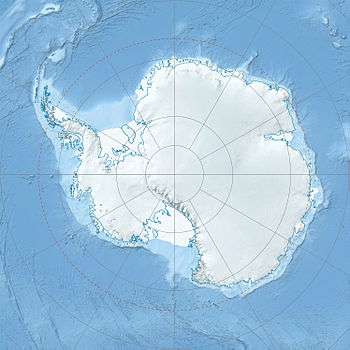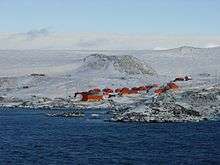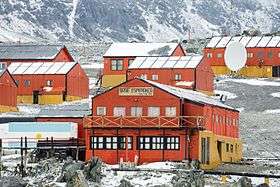Esperanza Base
| Esperanza Base Base Esperanza | ||
|---|---|---|
| All-civilian Antarctic base | ||
|
View of Esperanza Base, January 2016 | ||
| ||
|
Motto: Spanish: Permanencia, un acto de sacrificio ("Permanence, an act of sacrifice") | ||
 Esperanza Base Location within Antarctica | ||
| Coordinates: AR 63°24′S 56°59′W / 63.400°S 56.983°WCoordinates: AR 63°24′S 56°59′W / 63.400°S 56.983°W | ||
| Country |
| |
| Region | Graham Land, Antarctic Peninsula | |
| Location | Hope Bay, Trinity Peninsula | |
| Established | 1953 | |
| Named for | Spanish: Base Esperanza, ("Hope Base") | |
| Government[lower-alpha 1] | ||
| • Type | Directorate | |
| • Body | Argentine National Antarctic Directorate | |
| Area | ||
| • Urban[lower-alpha 2] | 0.3744 ha (0.9252 acres) | |
| Elevation | 25 m (82 ft) | |
| Population (2014) | 55 | |
| Status | Active and operational all year-round | |
Esperanza base (Spanish: Base Esperanza, "Hope Base") is a permanent, all year-round Argentine research station in Hope Bay, Trinity Peninsula (Graham Land, Antarctic Peninsula). It is one of only two civilian settlements on Antarctica (the other being the Chilean Villa Las Estrellas). The Base's motto is "Permanencia, un acto de sacrificio" ("Permanence, an act of sacrifice").
Description

Built in 1953,[1][2][3] the base houses 55 inhabitants in winter, including 10 families and 2 school teachers. Provincial school #38 Presidente Raúl Ricardo Alfonsín (formerly named Julio Argentino Roca) was founded in 1978 and acquired independent status in 1997. It maintains the furthest South Scout troop. The base has an Argentine civil registry office where births and weddings are recorded.[4]The base has tourist facilities that are visited by about 1,100 tourists each year. The LRA 36 Radio Nacional Arcángel San Gabriel radio station started transmitting in 1979. A wind generator was installed in 2008, mounted by INVAP. video
The 43 buildings of the station have a combined space of 3,744 square metres (40,300 sq ft) covered;[5] 18,000 litres (4,800 US gal) of fuel are used annually by the four generators to produce electricity for the station. Research projects include: glaciology, seismology, oceanography, coastal ecology, biology, geology, and limnology.
People
The base has some measure of fame because it is the birthplace of Emilio Marcos Palma, the first person to be born in Antarctica. There have been at least seven other children born at the base.[6][7]
Historic site
A group of items or structures of historic significance at, or close to, the base have been designated a Historic Site or Monument (HSM 40), following a proposal by Argentina to the Antarctic Treaty Consultative Meeting. These comprise a bust of General San Martin, a grotto with a statue of the Virgin of Lujan, a flagpole erected in 1955, and a cemetery with a stele commemorating Argentine expedition members who died in the area.[8]
Cemetery at Esperanza Station
Climate
The mean temperatures are −5.5 °C (22.1 °F) and range throughout the year from −10.8 °C (12.6 °F) in winter to 0.2 °C (32.4 °F) in summer. The presence of two months with temperature means just barely above freezing means the climate is classified as a polar tundra (ET) climate in the Köppen system. The temperature trend since 1948 is +0.0315 °C/yr (+0.0567 °F/yr) (annual), +0.0413 °C/yr (+0.0743 °F/yr) (winter) and +0.0300 °C/yr (+0.0540 °F/yr) (summer). The highest temperature recorded was 17.5 °C (63.5 °F) on 24 March 2015.[9]
| Climate data for Esperanza (1961–1990, extremes 1945–present) | |||||||||||||
|---|---|---|---|---|---|---|---|---|---|---|---|---|---|
| Month | Jan | Feb | Mar | Apr | May | Jun | Jul | Aug | Sep | Oct | Nov | Dec | Year |
| Record high °C (°F) | 14.9 (58.8) |
15.5 (59.9) |
17.5 (63.5) |
15.9 (60.6) |
17.2 (63) |
13.3 (55.9) |
14.0 (57.2) |
13.0 (55.4) |
11.4 (52.5) |
17.0 (62.6) |
14.3 (57.7) |
14.6 (58.3) |
17.5 (63.5) |
| Average high °C (°F) | 3.1 (37.6) |
2.6 (36.7) |
−0.4 (31.3) |
−3.4 (25.9) |
−5.6 (21.9) |
−6.6 (20.1) |
−6.4 (20.5) |
−6.2 (20.8) |
−2.7 (27.1) |
0.3 (32.5) |
1.3 (34.3) |
3.2 (37.8) |
−1.7 (28.9) |
| Daily mean °C (°F) | 0.5 (32.9) |
−0.5 (31.1) |
−3.1 (26.4) |
−7.3 (18.9) |
−9.6 (14.7) |
−10.9 (12.4) |
−10.8 (12.6) |
−10.5 (13.1) |
−7.0 (19.4) |
−3.6 (25.5) |
−1.7 (28.9) |
0.4 (32.7) |
−5.3 (22.5) |
| Average low °C (°F) | −1.8 (28.8) |
−2.9 (26.8) |
−6.4 (20.5) |
−11.1 (12) |
−13.4 (7.9) |
−15.1 (4.8) |
−15.0 (5) |
−14.7 (5.5) |
−11.1 (12) |
−7.4 (18.7) |
−4.6 (23.7) |
−2.1 (28.2) |
−8.8 (16.2) |
| Record low °C (°F) | −8.5 (16.7) |
−13.2 (8.2) |
−20.9 (−5.6) |
−26.0 (−14.8) |
−29.6 (−21.3) |
−30.0 (−22) |
−38.4 (−37.1) |
−32.0 (−25.6) |
−32.6 (−26.7) |
−23.2 (−9.8) |
−18.0 (−0.4) |
−9.7 (14.5) |
−38.4 (−37.1) |
| Average precipitation mm (inches) | 56.2 (2.213) |
65.0 (2.559) |
75.5 (2.972) |
59.1 (2.327) |
54.4 (2.142) |
47.4 (1.866) |
54.1 (2.13) |
72.1 (2.839) |
62.2 (2.449) |
56.4 (2.22) |
65.0 (2.559) |
59.0 (2.323) |
726.4 (28.598) |
| Average precipitation days (≥ 0.1 mm) | 14 | 14 | 17 | 17 | 14 | 11 | 13 | 15 | 15 | 15 | 16 | 16 | 177 |
| Average snowy days | 16 | 15 | 16 | 16 | 14 | 13 | 14 | 14 | 16 | 15 | 16 | 16 | 181 |
| Average relative humidity (%) | 82 | 80 | 80 | 80 | 80 | 79 | 80 | 80 | 79 | 80 | 81 | 80 | 80 |
| Mean monthly sunshine hours | 93.0 | 127.1 | 89.9 | 60.0 | 31.0 | 12.0 | 21.7 | 43.4 | 87.0 | 136.4 | 144.0 | 161.2 | 1,006.7 |
| Mean daily sunshine hours | 3.0 | 4.5 | 2.9 | 2.0 | 1.0 | 0.4 | 0.7 | 1.4 | 2.9 | 4.4 | 4.8 | 5.2 | 2.8 |
| Source #1: Weatherbase (temperatures),[10] NOAA (precipitation),[11] Servicio Meteorológico Nacional (precipitation and snowy days)[12][13] | |||||||||||||
| Source #2: Meteo Climat (record highs and lows),[14] Deutscher Wetterdienst (sun, 1982–1990 and humidity, 1982–1995)[15] | |||||||||||||
See also
Notes
- ↑ Operated by Argentine Antarctic Institute
- ↑ Indoors area
References
- ↑ Interview with General Leal by the Meeting channel
- ↑ official site
- ↑ ESPERANZA at marambio.aq
- ↑ Registro civil "Base Esperanza"
- ↑ Google Earth satellite images
- ↑ 60 años de Base Esperanza - Fundación Marambio
- ↑ El primer antártico es argentino Archived December 6, 2014, at the Wayback Machine. - Fundación Marambio
- ↑ "List of Historic Sites and Monuments approved by the ATCM (2012)" (PDF). Antarctic Treaty Secretariat. 2012. Retrieved 2013-12-31.
- ↑ Mccarthy, Tom (31 March 2015). "Antarctica records unprecedented high temperatures in two new readings". The Guardian. Retrieved 8 July 2015.
- ↑ "Weatherbase: Historical Weather for Base Esperanza". Weatherbase. Retrieved February 4, 2013.
- ↑ "Base Esperanza Climate Normals 1961–1990". National Oceanic and Atmospheric Administration. Retrieved January 23, 2016.
- ↑ "B. Espernza Statistical Data (1961-1990)" (in Spanish). Servicio Meteorológico Nacional. Retrieved January 23, 2016.
- ↑ "Valores Medios de Temperatura y Precipitación-Antártida: Base Esperanza" (in Spanish). Servicio Meteorológico Nacional. Retrieved January 23, 2016.
- ↑ "Station Base Esperanza" (in French). Meteo Climat. Retrieved June 6, 2016.
- ↑ "Klimatafel von Esperanza (Argentinien) / Antarkt. Halbinsel / Antarktis" (PDF). Baseline climate means (1961-1990) from stations all over the world (in German). Deutscher Wetterdienst. Retrieved January 23, 2016.
Further reading
- Antarctica. Sydney: Reader's Digest, 1985, p. 156-157.
- Child, Jack. Antarctica and South American Geopolitics: Frozen Lebensraum. New York: Praeger Publishers, 1988, p. 73.
- Lonely Planet, Antarctica: a Lonely Planet Travel Survival Kit, Oakland, CA: Lonely Planet Publications, 1996, 302-304.
- Stewart, Andrew, Antarctica: An Encyclopedia. London: McFarland and Co., 1990 (2 volumes), p. 469.
- U.S. National Science Foundation, Geographic Names of the Antarctic, Fred G. Alberts, ed. Washington: NSF, 1980.
External links
| Wikimedia Commons has media related to Esperanza Station. |
- Council Of Managers Of National Antarctic Programs: Base Esperanza
- Temperatures
- (Spanish) Argentine Army's site about the base
- Official website Direccion Nacional del Antartico
- (Spanish) Fundaciòn Marambio Esperanza Base page
- COMNAP Antarctic Facilities
- COMNAP Antarctic Facilities Map


